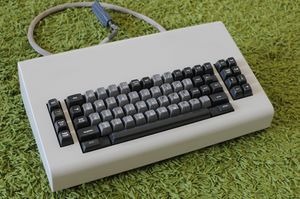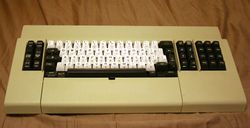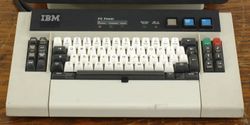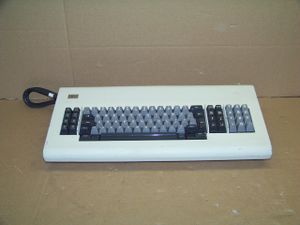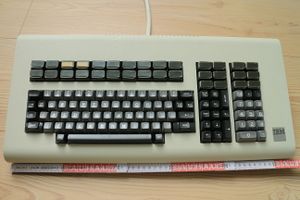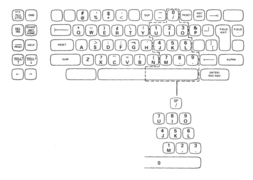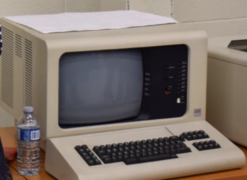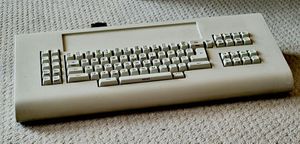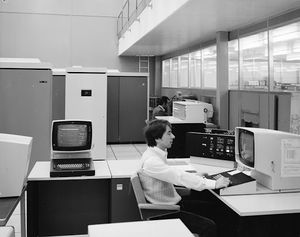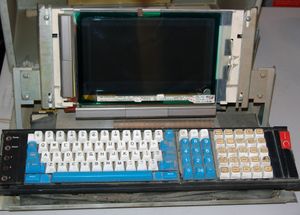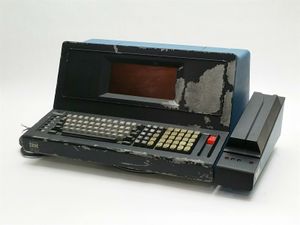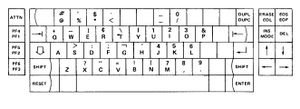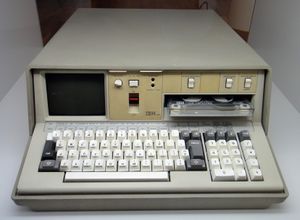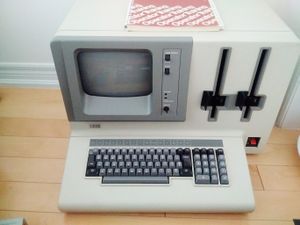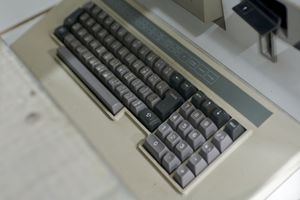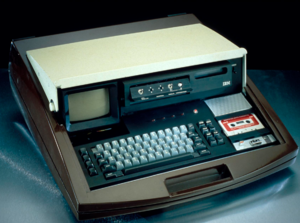IBM Beam Spring Keyboards
IBM's first mass produced iteration of an electronic capacitive PCB toggle switch, known colloquially as a beam spring, is a keyboard switch that was marketed in IBM's business products from 1971 until approximately 1985. These replaced special adaptations of the Selectric typewriter that were modified to communicate with mainframes during the early 1960s as well as IBM keyboards in the late 1960s and early 1970s that used Microswitch switches.
This article serves as a comprehensive overview of those keyboards that were produced with beam spring switches given the information and documentation that is still available. Due to the scarce nature of some information and the low quantity of remaining keyboard examples for some models, this list is non-exhaustive and may be updated as more models are discovered or new information is presented. This list is organized sequentially by IBM model numbers, not chronologically and is bisected into discrete and integrated keyboard models.
Contents
Discrete Beam Spring Keyboards
3101
Launched in 1979, the 3101 is a low cost serial ASCII terminal designed to work with both IBM systems, and systems made by competing vendors. Its keyboard had the same physical key arrangement of the 87-key 3278 keyboards (or the 88-key Japanese layout), but featured a different housing and a different keycap color scheme. IBM later produced a Model F version that was interchangeable with the beam spring one.
- IBM 3101 Display Station
3275 & 3277
The IBM 3275 and 3277 were the original terminals of the IBM 3270 Information Display System that launched in 1971. The IBM 3275 would attach to an IBM System/360 or System/370 via an IBM 2701 Data Adapter Unit, IBM 2703 Transmission Control or an Integrated Communications Adapter, and the 3277 would attach to an IBM 3271 or 3272 Control Unit.[1] But otherwise, the two terminals shared the same basic keyboard designs.
These beam spring versions of the keyboards are known as "Type B" by IBM, with "Type A" being the original Micro Switch SW Series based keyboards. The 66-key keyboard was available in keypunch-like data entry and typewriter layouts, whereas the 78-key was typewriter only. The 78-key was additionally available in an operator console variant with a layout based on the IBM 1052 Model 7 I/O Printer-Keyboard.
These keyboards could have smooth or textured keycap tops depending if it was intended for world trade or not.[2]
3276, 3278 & 3279
87-key Typewriter layout with engraved green alternate legends[3]
87-key Typewriter layout APL tripleshot orange legends[4]
The IBM 3276 and 3278 Display Stations were terminals first appearing in 1977 and intended for the System/370 and later series of IBM mainframes. 3276 and 3278 differed by 3276's inclusion of an integrated control unit.[5] The IBM 3279 was IBM's first color terminal that followed later in 1979. They shared the same basic pool of keyboards and associated part numbers,[6] available with 75 and 87-key layouts (76 and 88 for Katakana respectively) with different legends for a myriad of purposes including data entry (75-key only) and typewriter usage.
IBM 3278 Model 2A (also written as "A02") and 3279 Model 2C were operator console versions of their regular terminals intended for IBM 43X1 series processors and had the same 24-line screen as the regular model 2s but the bottom 4 lines were reserved for CPU operations. They had a version of the 75-key keyboard with extra control buttons for the host processor's fundamental operations such as power and initial microcode loading (IML), status LEDs, and green "START" and red "STOP" keys. Additionally for 3279s, an "Attribute Select" version of the 87-key keyboard was available that added various unique legends to the 12-key bank for programmed symbols (PSA to PSF), extended highlighting ("a" with background, radial lines or underscore) and extended colouring (solid rectangular blocks of colour).[7]
3727
The IBM 3727 Operator Console was designed to be attached to the the IBM 3725 Communications controller. The 3727 keyboard shares the physical layout of the 3101 keyboard but lacks the extensive DIP switch suite.
4978
The IBM 4978 Display Station is a terminal for the IBM Series/1 minicomputer. The default keyboard configuration from IBM came with a 122-key layout, including 32 relegendable programmable function keys. The 4978 terminal was offered by IBM two years after the initial launch of the Series/1 as a response to customer requests for improvement to the 4979 Display Station, which was previously the only operator data entry terminal for the Series/1.
As opposed to the predefined layout of the 4979, the keyboard for the 4978 was offered as a use-case configurable RPQ, (IBM's abbreviation for "request for price quotation", meaning that a given item was nonstandard but was available upon request) and according to the Series/1 system summary guide from September 1979, "Several keyboards are available [with the 4978 terminal] to permit a variety of display station configurations".[8] The extent of what other keyboard models were available is unknown, but from the examples that remain, it seems that IBM used a standard PCB and mounting plate on which keys were configured or rearranged at the factory to match a customer's needs.
The unused holes for keys were covered up with tape (shown above) and a custom made case top would be made to fit around the desired layout.
IBM designed a special ruggedized version of the Series/1 specifically for the US Marine Corps in 1980 called the IBM Series/1 model 4110 Automated Data Processing Equipment for the Fleet Marine Force (ADPE-FMF). This version of the Series/1 included a ruggedized, portable version of the 4978 that was protected from water, dust, sunlight, shock, and vibration.[9] The original 4978 terminals for the 4110 used keyboards with the standard 122 key layout, but featured black metal cases styled similarly to the 3277 keyboards (shown above). The 4110 was dubbed by Marine Corps operators "The Green Machine" because of the main unit's green color and the green screens of the terminals.
5251 & 5252
- 5250 Information Display System
85 key Katakana keyboard (While the image counts the keys to 86, key number 63 doesn't seem to exist)[10]
66 key data entry keyboard w/o split spacebar (US)[11]
67 key data entry split spacebar layout diagram[10]
The IBM 5251 and 5252, part of the IBM 5250 Information Display System, are video terminals that were meant to be application configurable means of data entry, located away from, or directly attached to the host system. They could be attached to a variety of hosts, including: series /1, system/34 or system/38. IBM suggested using the terminals in areas such as a sales counter, an order entry department or a receiving department.
The 5252 differed from the 5251 in that the 5252 shared a single display that was split with a mirror between two operators to create two screens, however both units shared the same keyboard offerings. They featured four different keyboards: a 83 key keyboard (standard), a 86 key keyboard (Katakana), a 66 key keyboard (data entry) and a 67 key keyboard (data entry with split spacebar). The 83 key keyboard shares its layout with the later Model F 83 key IBM System/23 Datamaster, IBM 5291 terminal and IBM PC keyboards as well as the 5280 Distributed Data Station keyboards discussed below.
The 66 key variant dropped the number pad and featured "data entry" key legends, shown above. The 67 key layout was nearly identical to the 66 key layout, but had a split spacebar with a 3 unit zero key on the right side. The Katakana variant had 3 extra keys to accommodate the expanded character set. Legends were offered in several different languages, including German and Japanese, shown above.
The 5250 system offered a light pen accessory which allowed the user to select highlight and copy text by dragging the light pen across the screen.
5253 & 5254
- 5520 Administrative System
IBM 5253 Display with keyboard[12]
The IBM 5253 Display Station and the dual screen 5254 are video terminals made for the IBM 5520 Administrative System, and were amalgamations of the 5251/5252 and the later 6580 Displaywriter System. The terminals, which looked identical to the 5251/5252, supported 3270 emulation and were designed to create, process and manage documents locally or remotely.
The keyboards which were almost identical to the 6580 Displaywriter, had two known layout options: an 82 key, 92 character keyboard and an 84 key, 96 character keyboard (shown above). The major differences between the keyboards of the Displaywriter and the Administrative System were the color of the keys, and the legends, with the Displaywriter having white keys and the Administrative System having black keys and more specialized legends.
Not very much is known about this system because it was it was a commercial failure and was withdrawn from marketing only three and a half years after the first order was shipped.[13]
5281 & 5285
The 5281 and 5285 are video terminals made for the 5280 Distributed Data System. Described as a low cost way to enter data into and communicate data with larger computers, the 5280 offered increased performance from the 3740 Data Entry System which it was aiming to replace. Unique among IBM terminals, the 5285 was able to act as a controller and process data on the spot without being connected to a host device. The keyboard offerings were identical to the offerings for the 5250 System, however the bezels on the sides were shortened and the bottom bezel was elongated, to create a palm rest. As a result, the standard 83 key keyboard has the same form factor as the later Model F IBM 5291 terminal and Datamaster 5324 keyboards, and was the first keyboard to have this form factor.
The top of the case is a cheaper and thinner plastic than on most beamsprings, and also yellows with age and light exposure, unlike most other models. While the legends are mostly identical to those from the 5250 System, there are a handful of unique legends on the number pad and function cluster.
These keyboards use a speaker for auditory feedback similar to the 6580 Displaywriter and 4978 Display Station keyboards. Bizarrely, the speaker location was changed midway through production and was moved from being mounted in the upper right to the bottom left on later keyboards.
6580
The IBM 6580 Displaywriter is a word processor introduced by IBM in 1980. It featured two keyboard configurations: 82-key (with 92 characters) and 84-key (with 96 characters). One unusual feature was that the Caps Lock key physically locked down when pressed. The keyboard also contained a speaker instead of the click solenoid found in other Beam Spring keyboards. The Displaywriter was most likely the last IBM machine to feature a beam spring keyboard. The next year, IBM launched the System/23 Datamaster and the 5150 Personal Computer.
7485
The IBM 7485 Display Station terminal is mentioned in certain documentation, and may have been a variant of the 3101.
Integrated Beam Spring Keyboards
1130
Contrary to popular belief, the 1130 was created and sold years before the beam spring patent was filed, and does not have beam spring switches, however the keycaps should be interchangeable.
2260
Contrary to popular belief, the 2260 was created and sold years before the beam spring patent was filed, and does not have beam spring switches, however the keycaps should be interchangeable.
3036
The IBM 3036 Processor Complex Console was an interface hub that was used to input and access data on the 3031, 3032 and 3033 processor models of the 3030 Processor Complex. The 3036 console, as well as the rest of the Processor Complex line, used the System/370 architecture and were sold as high end mainframes intended to be replacements for older System/370 models.
The 3036 console was launched on March 25, 1977 as a standard option for the 3033 processor. Nicknamed "The Big One", the 3033 processor was the most powerful computer that IBM had to offer at the time. On Oct. 7, 1977, the identical looking 3031 and 3032 models were launched as cheaper, but slower, alternatives to the 3033, both also coming with 3036 consoles as a standard option. The 3036 console itself had two display stations that could work in parallel to allow for multiple program jobs to be executed at once, taking advantage of the instruction pipelining offered by the 303X processors.
The two display stations featured a 66 key keyboard that is reminiscent of the 3277 66 key keyboard, however, the keyboards for the 3036 were painted black and have an extremely long base, as is shown above. It also appears that they may have had specialized legends, but no documentation of the legends or pictures close enough to read them are currently available. There are also currently no documented remaining examples of the 3036. As such, it's unknown whether the keyboards or display stations were detachable or adjustable in any capacity, however, they appear to be fixed to the workstation table.
3604
Launched in 1973, the IBM 3604 Keyboard Display keyboards were part of the IBM 3600 Financial Communication System, a set of terminals and printers for bank tellers, and the networking equipment required to interface them with an IBM mainframe. The 3604 keyboard displays were the 3600's terminals, there were six models of which Models 1 - 4 featured beam spring keyboards (Models 5 and 6 used smaller keys which, at least in later production examples, used rubber dome switches). Model 1 was a compact unit which could be equipped with one of three keyboard options:
- A 30-key Numeric Keypad, which featured a 15-key numeric keypad, and another 15-key block whose functionality was determined by the system software.
- A Data Entry layout, which was based on the Numeric Keypad.
- A 45-key Extended Numeric Keypad, which added another 15-key programmable function block to the keyboard.
Models 2 - 4 were larger units which differed by screen size. There were two more keyboard options available in addition to the ones available for the Model 1:
- A 74-key Alphanumeric layout, which featured an alphanumeric keypad with the same physical alphanumeric keypad layout as that on the 3277 78-key terminals. To the right of that was a numeric keypad and a number of programmable function keys. It is perhaps interesting to note that if one takes this layout, removes the Reset and Enter keys, replaces the Return and Back Tab keys with an ISO-style return, replaces the Tab and Lock key with a single L-shaped key the result is quite similar to the physical key arrangement of the later IBM 5100.
- A 94-key Extended Alphanumeric layout, which added an additional 20 programmable function keys to the standard Alphanumeric layout.
The 3604 was replaced by the IBM 4704 which was launched in 1981. The 4704's Model F keyboard options have layouts inspired by the 3604.
3643
The IBM 3643 Keyboard Display is an industrial variant of the 3604, and was sold as part of the IBM 3630 and 3640 Plant Communication Systems. No available documentation remains for the Plant Communication System, however a brief description of the system's features is listed in documentation for the 8100 Information System,[14] which describes the terminal as an interactive input/output device that brings display capability to a wide range of industrialized work zones or offices. Common applications included: activity reporting, receiving and inspection and stores or warehouse control.
There were three terminal models, but the only distinction between each model was the maximum number of characters that could be displayed on the screen. Each terminal model could be equipped with either a keyboard that had 74 keys (77 keys for Katakana) or 94 keys (92 key for Katakana). The 74/77 key model had 8 programmable function keys as opposed to the 28 on the 94/92 key version shown above.
3741
The IBM 3741 Data Station keyboard, and the related IBM 3742 (which was effectively two 3741s integrated into the one desk back-to-back) were released by IBM in 1973. They were designed as a more modern (by the standards of the time) alternative to a keypunch by storing data on 8" floppy disks instead of punching holes onto card. The keyboard was somewhat similar in layout to that of the IBM 029 keypunch.
3767
The IBM 3767 Communications Terminal keyboard is a printer type terminal from IBM which featured an integrated Beam Spring keyboard.
4979
The IBM 4979 Display Station is a data entry/operator terminal that was launched in 1976 for the IBM Series/1 minicomputer. The terminal is visually reminiscent of IBM's earlier 2260 model terminal and features a 66-key data entry keyboard that has the same layout as the 3277 data entry keyboard, but with unique keys for the Series/1. Only certain keys such as the arrow keys, space bar and return keys were capable of continuously sending scan codes when held down. All letters, numbers and special characters required repeated tapping of the keys to generate more scan codes.
The terminal used a 64 character subset of the EBCDIC character set and had a fairly simple and limited usage: several keys on the keyboard went completely unused, shown as being blank in the pictures. The limited input and lack of programmable function keys on a system that was marketed on the premise of being entirely configurable, prompted customers to request a more adaptable option that could be better tailored to their use-cases. IBM responded by adding the 4978 terminal to the Series/1 lineup in 1978 as a RPQ.[8]
A noteworthy feature on the 4979 is that the knob on the lower right hand side of the screen contained the on/off switch, the brightness adjustment and the contrast. Pulling or pushing the knob would turn the terminal on and off, twisting the inner stem would adjust the brightness and the outer stem would adjust the contrast.[15]
5100
The IBM 5100 Portable Computer was one of the world's first portable computers. Introduced IBM in 1975, the 5100 was designed to run either BASIC, or BASIC and APL with the ability to toggle between either. The 75-key keyboard was available either with a standard layout, or an APL layout and featured the IBM beam spring modules.
5110
The IBM 5110 (launched 1978) was an updated version of the 5100 that supported additional peripherals. The keyboard and their layout were the same as those on the 5100 and on the 5120 but differed by the color of their keycaps.
5120
The IBM 5120 (launched 1980) was effectively the 5110 in a different form factor, with a larger screen and the tape drive replaced by a pair of 8" floppy drives. The keyboard and its layout was the same as those on the 5110.
SCAMP
IBM's SCAMP (Special Computer, APL Machine Portable), is a prototype computer developed in 1973. If not the world's first portable desktop computer, it is the world's first portable APL computer.
Created in the span of 6 months, the design concept went on to become the commercially available 5100 and 5110 computers, and the SCAMP's short development cycle and design philosophy of using off the shelf parts would become defining features of the development of the IBM PC 5150. The computer could fold its screen down to become a compact briefcase sized package, which is an idea, used slightly differently, to great success by Osborn and Compaq almost a decade later.
Because there is only one SCAMP computer and it's located at the Smithsonian, it's not fully confirmed whether it has beam spring switches. However, there are a few factors that strongly suggest that the computer does in fact use them in its keyboard. The Smithsonian confirms that the computer used existing components in order to expedite the creation of the prototype, and also confirms that one of those standard components was the keyboard which came from the IBM's Raleigh, North Carolina location[16] (the same location where beam springs and buckling springs were invented).
It can be seen that the keyboard layout is the same as a 3277 66 key keyboard. IBM did have a Microswitch version of this keyboard, but a Microswitch keyboard can be ruled out, because IBM's Microswitch keyboards did not use stepped keys for the 1 and back tab, and had larger reset and enter keys than are on the beam spring version (see the IBM 3277 typewriter keyboard). The keys on the SCAMP are the exact size and shape that would be expected on the beam spring version of the 3277. Furthermore, by 1973 IBM had already all but finished transitioning away from Microswitch keyboards to beam spring ones, and in the third picture shown here where the SCAMP is on display, it can be seen that some of the keys are bent left or right at odd angles but not bent at all up or down, which is a hallmark of the metal stem used in the beam spring switch mount.
System/3
System/6
The IBM Office was a word processor launched by IBM in 1977. Its keyboard has been described by some sources as being similar to that used by the later 5520 and DisplayWriter systems.
System/32
The System/32 was a midrange system, launched by IBM in 1975. It featured a console keyboard integrated into the computer unit, whose physical key layout could be described as a half way point between the layout of Selectric-based terminals such as the IBM 2741 and the keyboard of the IBM 5251 terminal which was designed for the later System/34.
System/38
The IBM System/38 Console was a midrange computer launched by IBM in 1979. In addition to the IBM 5250-series terminals that it was designed to operate with, it featured a console built into the computer unit whose keyboard had the same physical key arrangement as the 75-key 3278 keyboard.
References
- ↑ IBM — An Introduction to the IBM 3270 Information Display System (bitsavers.org)
- ↑ IBM — IBM 3275/3277 Parts catalog, March 1976 (bitsavers.org)
- ↑ Deskthority — 3278 1979 Plastic Case Beamspring and *Accessories*
- ↑ Deskthority — Great/Interesting Finds
- ↑ IBM — IBM 3270 Information Display System Description, Configuration and Physical Planning (bitsavers.org)
- ↑ IBM — IBM 3270 Information Display System - 3276/3278 Keyboard Assembly, Parts Catalog (bitsavers.org)
- ↑ IBM — IBM 3270 Information Display System: Color and Programmed Symbols (bitsavers.trailing-edge.com)
- ↑ 8.0 8.1 IBM — IBM Series/1 System Summary (bitsavers.org)
- ↑ Automated Data Processing Equipment for the Fleet Marine Force (ADPE-FMF), thesis by David Russell Aday & Merrill Lyman Pierce, Jr. dated June, 1982 (Internet Archive)
- ↑ 10.0 10.1 IBM — IBM 5250 Information Display System - Introduction, dated January, 1980 (Internet Archive)
- ↑ Deskthority — IBM beam springs photo thread!
- ↑ IBM — IBM 5520 Administrative System (Internet Archive)
- ↑ IBM — Exhibit of the IBM 5520 Administrative System (Internet Archive)
- ↑ IBM — An Introduction to the IBM 8100 Information System, dated October, 1978 (bitsavers.trailing-edge.com)
- ↑ IBM — IBM Series/1 - 4979 Display Station - Description, dated March, 1977 (bitsavers.org)
- ↑ Smithsonian — IBM SCAMP
External links
- IBM — IBM 3600 Finance Communication System: operating guide (bitsavers)
- IBM — IBM 5251 Display Station Models 1 and 11 Maintenance Information Manual (bitsavers)
- IBM — IBM System/32 Operator's Guide (bitsavers)
- IBM — IBM 3277 Display Station Models 1 and 2 Troubleshooting Guide (bitsavers, Internet Archive)
- Corestore's Collection — IBM System/3 5415 — Corestore page about the IBM System/3 with pictures of 3741 Data Station
- Corestore's Collection — IBM System/32 5320 — Corestore's IBM System/32 page
- Ed Thelen's Nike Missile Web Site — IBM 3600 Finance Communication System — IBM 3600 product announcement brochure
- Ed Thelen's Nike Missile Web Site — IBM 3767 Communication Terminal — IBM 3767 product announcement brochure
- Deskthority — 80s keyboard party — MMcM's USB conversion for vintage IBM keyboards




